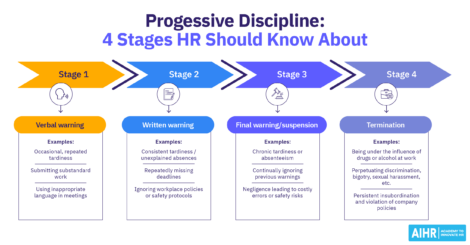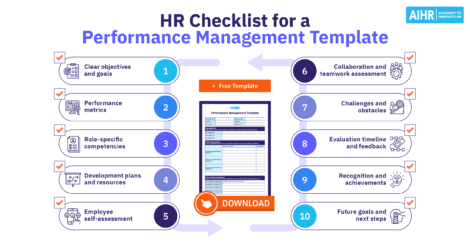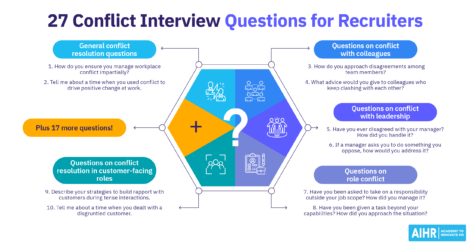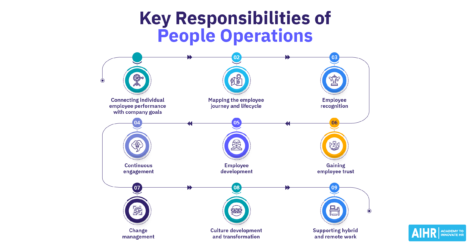[Free] Termination Letter Template and Guide to Writing a Professional Letter
Letting an employee go is tough, but a well-written termination letter can prevent legal issues and misunderstandings.

Handling employee terminations and writing termination letters are unavoidable parts of an HR professional’s role. In the U.S., for instance, there have been 1.8 million job terminations in one year, meaning HR has had to write 1.8 million termination letters.
Well-structured termination letters can mitigate potential legal challenges and make the termination process more professional and dignified. This article discusses writing clear, legally sound termination letters and provides a free, customizable template.
Contents
What is a termination letter?
Why a termination letter matters
7 key elements of a termination letter template
Free termination letter template
How to write a termination letter
Termination letter examples
What is a termination letter?
An employment termination letter confirms the end of an employment relationship between an employer and an employee. It’s a written explanation ensuring everyone is on the same page about why and how the employment will end.
Whether due to performance issues, company restructuring, or the natural end of a contract, delivering this news requires professionalism, empathy, and clear communication. A termination letter is vital in this process — it acts as a formal record and helps both parties navigate an emotionally charged situation with clarity and respect.
Why a termination letter matters
A termination letter is essential as it lays out all the key details, such as the reason for termination, the employee’s last working day, and any next steps required (such as returning company property or finalizing severance).
A termination letter covers both termination with cause and without cause. Termination with cause includes cases like serious misconduct, poor performance, or breaking workplace policies.
For example, if someone consistently fails to meet their goals despite receiving the necessary support or repeatedly engages in unethical behavior, a letter of termination with cause would detail these incidents to support the reason for termination.
Termination without cause, on the other hand, may happen during company restructuring, budget cuts, or the completion of a fixed-term contract or project. In these situations, a termination letter would inform the employee the termination is due to company circumstances and not their performance.
7 key elements of a termination letter template
A termination letter template can help you maintain a standardized approach to all termination letters your organization issues. It should be clear and comprehensive and include the following components to cover all necessary details:
- Employee details: Start with the basics, such as the employee’s full name, department, and the date they joined the company.
- Manager/supervisor details: Identify the employee’s direct manager or supervisor who would be involved in the termination process.
- Company information: Include the company’s name and contact details to formalize the document and ensure easy reference if needed.
- Date of and reasons for termination: Clearly state the employee’s last working day and provide clear, factual reasons for the termination. Whatever the reason, ensure clarity to minimize confusion or disputes.
- Severance pay or other benefits (if applicable): Outline any severance package, unused leave payout, or continuation of benefits. Providing specifics helps the employee understand their entitlements and can ensure legal compliance.
- Return of company property: Specify what items the employee must return (e.g., laptops or access cards) and the return date to ensure you account for company assets.
- Final steps: Detail the process for receiving the last paycheck and any continuation of benefits, such as healthcare coverage or retirement contributions. Mention whom the employee should contact for questions.
Also, remember that the tone of a termination letter is crucial. It should be respectful and free of ambiguity to maintain the employee’s dignity while safeguarding the company’s reputation. A well-crafted letter reflects the organization’s commitment to fairness and transparency.
Free termination letter template
To help make the termination process easier, AIHR has created a free, customizable termination letter template that includes the key elements mentioned above.
Please note: This template is only intended for general usage and does not constitute professional or legal advice. To ensure your termination letter is legally compliant, consult with a qualified legal professional.
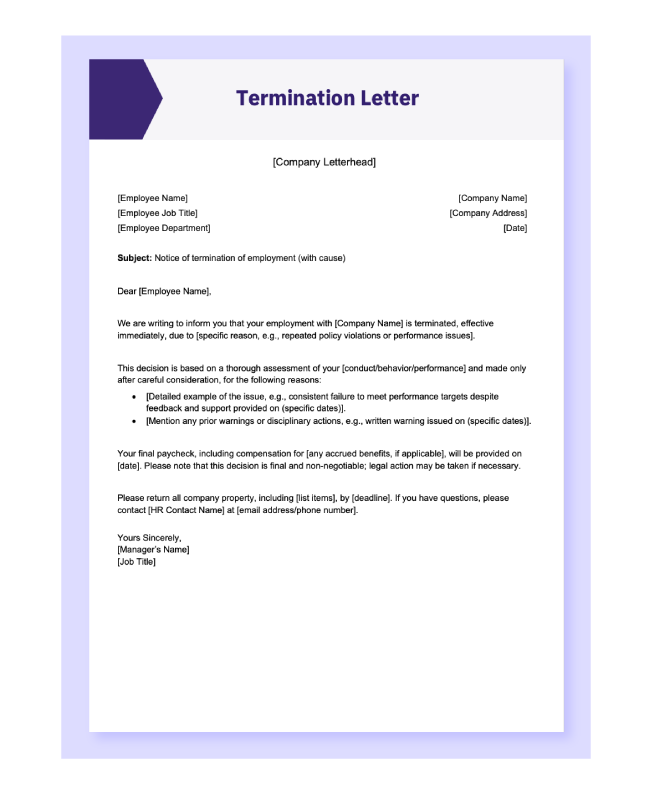
How to write a termination letter
Here’s a simple step-by-step guide you can follow when writing a termination letter:
Step 1: Use a professional letterhead
Start with your company’s letterhead, and include the company’s name, address, and contact details. This is an important part of standardizing your organization’s termination letters. Be sure to also include the date to establish the document’s formal timeline.
Step 2: Address the letter to the employee
Include all relevant employee details, such as their full name, job title, and, if applicable, their employee ID. Then, begin the letter itself with a formal salutation (e.g., “Dear [Employee’s Name]”).
Step 3: Clearly state the intent to terminate
Open with a direct statement of the intent to terminate employment and specify the effective termination date. For instance: “We are writing to inform you that your employment with [Company Name] will be terminated, effective [Date].”
Step 4: Provide detailed reasons for the termination
Clearly explain the reason for termination (whether with or without cause). Be factual and concise to avoid ambiguity or emotional language (e.g., “This decision is based on repeated performance issues despite efforts to address them through constructive feedback.”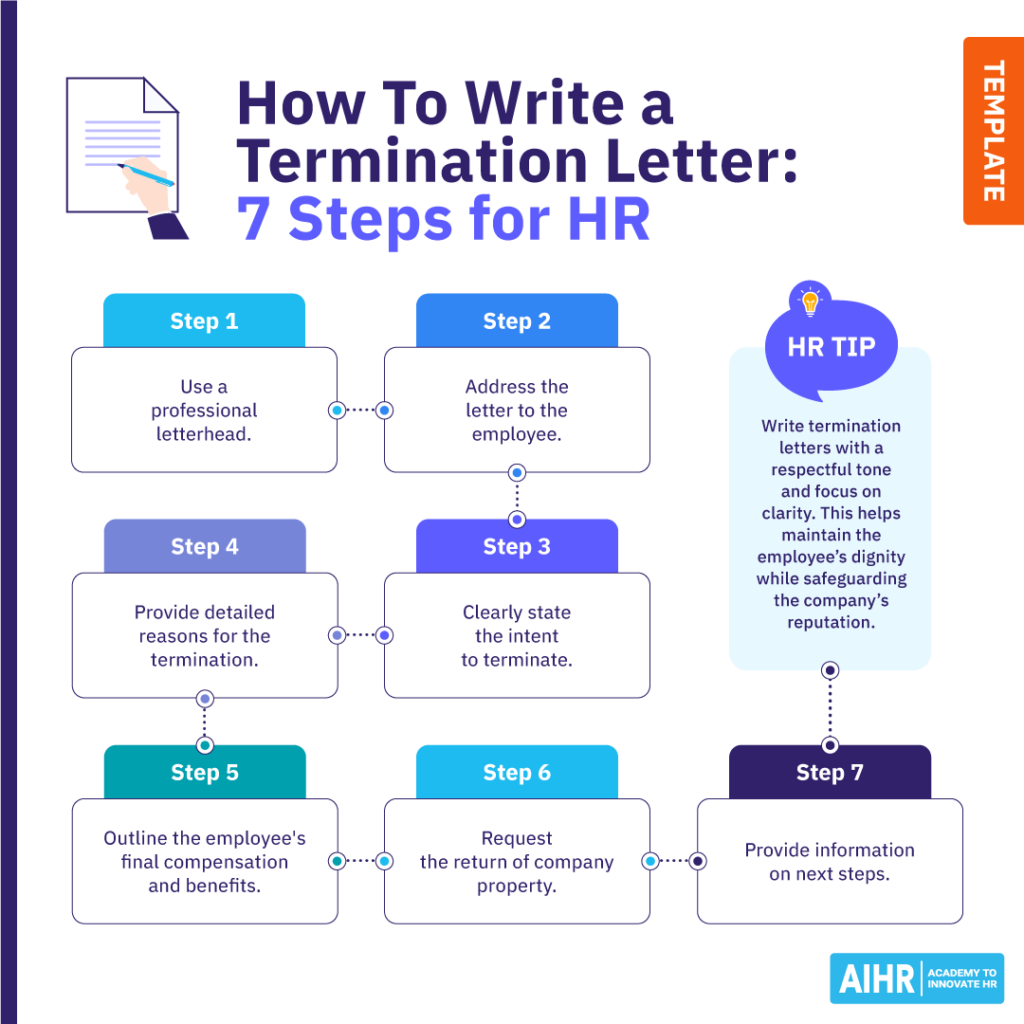
Step 5: Outline the employee’s final compensation and benefits
Provide details about the employee’s final paycheck, including payment for unused leave, overtime, or any other due compensation. Also, mention severance pay (if applicable), benefits continuation, and how the employee can collect these payments.
Step 6: Request the return of company property
List all company property the employee must return, such as laptops, ID cards, or keys. Specify a deadline and how these items should be returned. For example: “Please return all company-issued property, including your laptop and access badge, by [Date].”
Step 7: Provide information on next steps
Offer a point of contact for the employee to direct their questions to (typically someone from HR). If applicable, mention any additional support, such as career counseling, references, or job placement assistance.
Learn to handle terminations professionally
Learn the skills you need to facilitate employee terminations and other HR challenges professionally. Doing so requires you to develop HR policies, processes, and communication skills.
AIHR’s Talent Management & Succession Planning Certificate Program will teach you how best to handle sensitive information, manage your organization’s talent supply chain, and develop a strategic talent management framework.
Common mistakes and how to avoid them
When writing terminational letters, avoid making certain common mistakes that could complicate matters for the company or employee. These include not following a consistent format, omitting relevant employee details, being vague about the reason for termination, and excluding the next steps or a point of contact.
AIHR Subject Matter Expert, Laksh Sharma, recommends the following best practices for avoiding such mistakes:
- Not following a consistent format: Store soft copies of all termination letters on a secure internal database. If your company issues hard copies of termination letters, ensure each has a unique serial number for identification purposes. Ensure the language, tone, font, and format are consistent across all letters.
- Omitting relevant employee details: Termination letters are subject to inclusion in case of legal disputes, so be sure to include details like employee name, ID, designation, date of joining, etc., in each letter.
- Being vague about the reason for termination: It’s important to include the specific reason (e.g., policy breach, poor performance, business restructuring) to make the letter legally indisputable.
- Excluding next steps or a point of contact: While the termination letter ends employment, HR should include the point of contact who the ex-employee can reach after the termination. This helps the employees and gives them the support they may need.
Termination letter examples
Here are sample termination letters that apply to different scenarios. You can edit them to reflect your company’s policies and tone.
Example 1: Termination with cause
[Employee’s Full Name]
[Job Title]
[Department]
[Company Name]
[Company Address]
[Date]
Subject: Notice of termination of employment (with cause)
Dear [Employee’s Name],
We are writing to inform you that your employment with [Company Name] is terminated, effective immediately, due to [specific reason, e.g., repeated policy violations or performance issues].
This decision is based on a thorough assessment of your [conduct/behavior/performance] and made only after careful consideration for the following reasons:
- [Detailed example of the issue, e.g., consistent failure to meet performance targets despite feedback and support provided on (specific dates)].
- [Mention any prior warnings or disciplinary actions, e.g., written warning issued on (specific dates)].
Your final paycheck, including compensation for [any accrued benefits, if applicable], will be provided on [date]. Please note that this decision is final and non-negotiable; legal action may be taken if necessary.
Please return all company property, including [list items], by [deadline]. If you have questions, please contact [HR Contact Name] at [email address/phone number].
Yours Sincerely,
[Manager’s Name]
[Job Title]
Example 2: Termination without cause
[Employee’s Full Name]
[Job Title]
[Department]
[Company Name]
[Company Address]
[Date]
Subject: Notice of termination of employment (without cause)
Dear [Employee’s Name],
We regret to inform you that your position with [Company Name] will be terminated, effective [termination date]. This decision is not related to your performance but is due to [reason, e.g., company restructuring or budget constraints].
You will receive your final paycheck, including any accrued leave or overtime, on [date]. Additionally, you will receive severance pay as outlined in our company policy, totaling [amount]. Information regarding the continuation of benefits through [e.g., COBRA] will be provided separately.
Please return all company property, including [list items], by [deadline]. Should you require further assistance, feel free to reach out to [HR Contact Name] at [email/phone].
We thank you for your contributions to [Company Name] and wish you all the best in your future endeavors.
Sincerely,
[Manager’s Name]
[Job Title]
Example 3: Contract termination
[Employee’s Full Name]
[Job Title]
[Department]
[Company Name]
[Company Address]
[Date]
Subject: Confirmation of end of employment contract
Dear [Employee’s Name],
We are writing to formally notify you that your employment contract with [Company Name], dated [start date], will conclude as scheduled on [contract end date]. This marks the end of our agreement as per the terms outlined in your contract.
We want to thank you for your dedication to [specific project or company goal] during your time with us. Your final paycheck will include compensation for any unused leave or other entitlements and will be processed on [date].
Please return all company property, including [list items], by [deadline]. If you have any questions or require employment verification, please contact [HR Contact Name] at [email/phone].
Best regards,
[Manager’s Name]
[Job Title]
Example 4: Probationary period termination
[Employee’s Full Name]
[Job Title]
[Department]
[Company Name]
[Company Address]
[Date]
Subject: Notice of termination of employment during the probationary period
Dear [Employee’s Name],
We are writing to inform you that your employment with [Company Name] is terminated effective [date] due to [specific reason, e.g., repeated policy violations or performance issues].
This decision is based on a thorough assessment of your [conduct/behavior/performance] and made only after careful consideration for the following reasons:
- [Detailed example of the issue, e.g., consistent failure to meet performance targets despite feedback and support provided on (specific dates)].
- [Mention any prior warnings or disciplinary actions, e.g., written warning issued on (specific dates)].
Your final paycheck, including compensation for [specific entitlements, if applicable], will be processed on [date]. Please ensure all company property, such as [list items], is returned by [deadline].
If you have any questions or need further assistance, feel free to contact [HR Contact Name] at [email/phone].
We wish you the best in your future endeavors.
Yours Sincerely,
[Manager’s Name]
[Job Title]
To sum up
Handling employee terminations is one of the most sensitive responsibilities you will face as an HR professional. Whatever the reason, write each termination letter thoughtfully, providing clarity and maintaining professionalism.
In addition to being a formal requirement, this letter reflects your organization’s commitment to fairness, transparency and respect, which are especially important during what must be a difficult time for the employee in question. It can also protect your company’s reputation and minimize its exposure to potential legal risks.
By using structured templates and avoiding common mistakes, you can demonstrate care and consistency, reinforcing a positive workplace culture even in challenging circumstances.
Learn more
Related articles
Are you ready for the future of HR?
Learn modern and relevant HR skills, online







